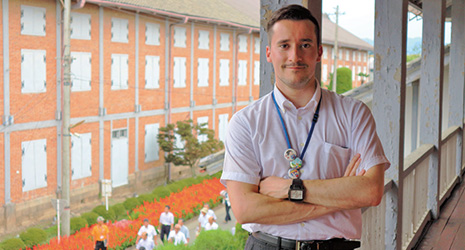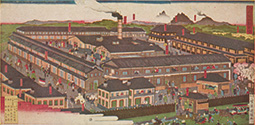Home > Highlighting JAPAN > Highlighting Japan October 2017 > My Way
Highlighting JAPAN


Silk Ties: The French Connection
A young French man with a strong sense of mission is fostering cultural exchanges between Tomioka City, location of Japan’s first modern silk reeling plant, and Lyon, a city known as the home of silk products in France.
Established in 1868, the Government of Meiji Japan promoted the country’s modernization by introducing advanced technology and new social systems from Western nations following a period of more than 200 years under the government of the Tokugawa shogunate in which foreign trade was banned. The Meiji government hired a number of foreign advisors from the West specializing in a range of fields. Known as “Oyatoi gaikokujin” (hired foreigners)*, these advisors made a significant contribution to the modernization of Japan.
A French engineer named Paul Brunat (1840–1908) was one of them. He founded the Tomioka Silk Mill, which was sponsored and run by the government during the initial years of the Meiji period (1868–1912). About 150 years later, this historic mill was added to the UNESCO World Heritage List. Today, Damien Robuchon, a young French man, plays an active role as a coordinator for international relations (CIR) to publicize the World Heritage site in the city of Tomioka.
Being a CIR requires a high level of proficiency in the Japanese language. CIRs are usually assigned to divisions or departments responsible for international exchange programs in local government offices. CIRs are employed as one of the positions of the Japan Exchange and Teaching (JET) Programme, which invites young college graduates from around the world to work at Japan’s local government offices and others, aiming primarily to promote foreign language education and grass-roots international exchanges between Japan and other nations. The program is administered through the collaboration of Japan’s local government authorities, the Ministry of Internal Affairs and Communications, the Ministry of Foreign Affairs (MOFA), the Ministry of Education, Culture, Sports, Science and Technology, and the Council of Local Authorities for International Relations. Damien became fascinated with the JET Programme while he was attending graduate school in Japan. He applied for the program and was selected as a participant in 2013.
“While I was hunting for towns and cities that had announced that they were hiring for CIR positions, I happened to become aware that there was a world-class silk reeling mill in operation in Tomioka, Gunma Prefecture, and that Paul Brunat had played a significant role in establishing the facilities. His historical achievements in Japan made me feel very proud as a French citizen. I was strongly convinced that I would be able to do an important job in Tomioka, and applied for the CIR position there,” says Damien.
Damien has been involved in a range of activities, serving as a guide for foreign dignitaries visiting the Tomioka Silk Mill, working as an interpreter or translator for international exchange programs, teaching French to groups of local citizens, and translating historical contracts and other documents written in French that are related to the Tomioka Silk Mill.
The Tomioka Silk Mill was launched by the Meiji government in 1872 as a model for a government-run silk reeling mill in Japan under the direction of Paul Brunat. With this world-class silk reeling mill in operation, the Meiji government aimed to achieve better quality and higher production for raw silk, a major export item for Japan in those days. Paul Brunat played a pivotal role in designing the silk mill and installing machines in the facilities as well as implementing a rule for employment and wage increases.
The main buildings of the Tomioka Silk Mill were constructed by integrating traditional Japanese and French technologies, using a technique of timber-frame and brick construction. Their operation was discontinued in 1987, but the buildings are still standing in good condition even today. The Tomioka Silk Mill and Related Sites consisting of a silk reeling mill and three other facilities were added to the UNESCO World Heritage List in 2014.
It appears that the inclusion of the Tomioka Silk Mill as a World Heritage site has inspired people in Lyon in the southeast of France, which has a long history as a center of silk production, to run a campaign encouraging people to reflect on the value of their city’s industrial heritage. Accordingly, Lyon and Tomioka recently launched exchange programs.
There was a contact point in history between the two cities. Lyon’s silk textile business served as a leading industry in France for many years. When silkworm disease spread throughout Europe in the 1860s, damaging the silk industry, Lyon’s silk textile industry relied on raw silk imported from Japan for business survival. In 2015, a delegate from Tomioka City paid a visit to Lyon and held an exhibition “SOYEUX DESTINS” in collaboration with MOFA. During the visit, a friendship pact was signed between Tomioka and Paul Brunat’s home town of Bourg-de-Péage near Lyon.
There is a historical document confirming that Paul Brunat imported machines and invited engineers from the area around Lyon for the construction of the Tomioka Silk Mill. In fact, Ain, which is located to the northeast of Lyon, has launched initiatives to collaborate with the Tomioka Silk Mill in renovating an old copperware factory as a museum. Damien has been involved in the planning process for these exchange programs, not only by working as an interpreter.
It was also discovered recently that the reeling machine components used at the Tomioka Silk Mill during its initial years of operation were manufactured at this copperware factory in Cerdon, Ain. Damien says, “I was very fortunate to witness a historical moment of discovering a new element of the history between the two cities. It was extremely significant for both France and Japan to discover a historical fact that had long been neglected. I am excited to discover more facts between the two cities in the future course of ongoing research activities regarding the Tomioka Silk Mill.”
Today, Damien is busy preparing for a symposium to be held in Tomioka this October, inviting guests from Lyon and other related regions.
The house in which the Brunat family used to live is still preserved on the site of the Tomioka Silk Mill. “I sometimes wonder how he found his life here. I believe that Paul Brunat was a man of strong commitment and determination. In honor of Paul Brunat, I will make every possible effort to promote goodwill exchange programs between Japan and France,” affirms Damien.
In his efforts to foster cultural exchanges that reconnect Japan and France through historical silk ties dating back to the Meiji period, Damien is a present-day Paul Brunat.
Note
“Oyatoi-gaikokujin” refers to the practice, which was common in the late nineteenth century, of hiring Europeans and Americans as specialists to foster the importation into Japan of the advanced technologies, knowledge and systems of Europe and the United States in the services driven by the Edo shogunate and Meiji government.
© 2009 Cabinet Office, Government of Japan







